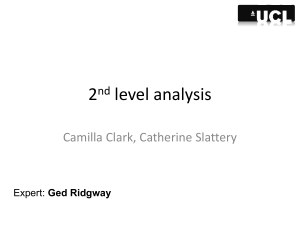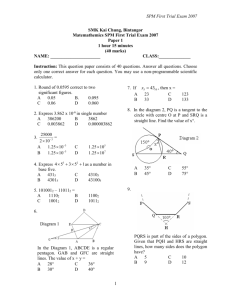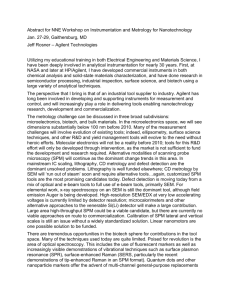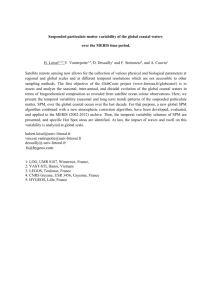2 nd Level Analysis
advertisement
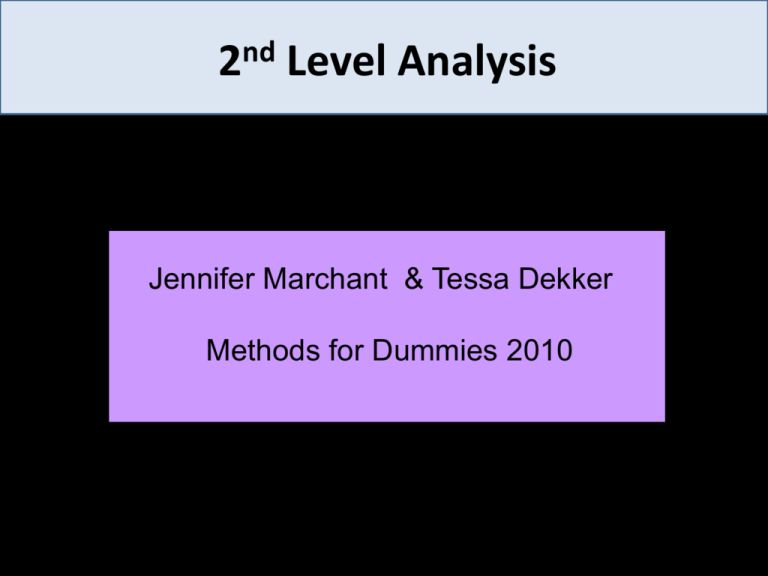
2nd Level Analysis Jennifer Marchant & Tessa Dekker Methods for Dummies 2010 2nd Level Analysis fMRI time-series Motion correction kernel Design matrix Smoothing General Linear Model Statistical Parametric Map Parameter Estimates Spatial normalisation Standard template Group Analysis: Fixed vs Random In SPM known as random effects (RFX) Group Analysis: Fixed-effects Fixed-effects • • • • specific to cases in your study can NOT make inferences about the population only takes into account within-subject variance useful if only have a few subjects (eg case studies) Because between subject variance not considered, you may get larger effects Fixed-effects Analysis in SPM Subject 1 Subject 2 Subject 3 Subject 4 Subject 5 Fixed-effects • multi-subject 1st level design • no 2nd level • each subjects entered as separate sessions • create contrast across all subjects c = [ 1 -1 1 -1 1 -1 1 -1 1 -1 ] • perform one sample t-test t cT ˆ Vaˆr (cT ˆ ) Group analysis: Random-effects Random-effects • CAN make inferences about the population • takes into account between-subject variance Methods for Random-effects Hierarchical model • Estimates subject & group stats at once • Variance of population mean contains contributions from within- & between- subject variance • Iterative looping computationally demanding Summary statistics approach SPM uses this! • • • • • 2 levels (1 = within-subject ; 2 = between-subject) 1st level design must be the SAME Sample means brought forward to 2nd level Computationally less demanding Good approximation, unless subject extreme outlier Friston et al. (2004) Mixed effects and fMRI studies, Neuroimage Random-effects Analysis in SPM Random-effects Session 1 contrast = [ 1 -1 1 -1 1 -1 1 -1 1 -1 ] Session 2 Session3 contrast = [ 1 -1 1 -1 1 -1 1 -1 1 -1 ] Session 4 contrast = [ 1 -1 1 -1 1 -1 1 -1 1 -1 ] Session 5 • 1st level design per subject • generate contrast image per subject (con.*img) • images MUST have same dimensions & voxel sizes • con*.img for each subject entered in 2nd level analysis • perform stats test at 2nd level contrast = [ 1 -1 1 -1 1 -1 1 -1 1 -1 ] contrast = [ 1 -1 1 -1 1 -1 1 -1 ] * (5/4) NOTE: if 1 subject has 4 sessions but everyone else has 5, you need adjust your contrast! 2nd Level Analysis FIRST LEVEL (per person) Data Design Matrix ̂1 ̂ Contrast Image SECOND LEVEL Group analysis t cT ˆ Vaˆr (cT ˆ ) SPM(t) 2 1 ̂ 2 ̂ 22 ̂11 ˆ112 ̂12 ̂ 122 One-sample t-test @ 2nd level Stats tests at the 2nd Level Choose the simplest analysis @ 2nd level : one sample t-test – Compute within-subject contrasts @ 1st level – Enter con*.img for each person – Can also model covariates across the group - vector containing 1 value per con*.img, Same design matrices for all subjects in a group Enter con*.img for each group member Not necessary to have same no. subject in each group Assume measurement independent between groups Assume unequal variance between each group Group 2 – – – – – Group 1 If you have 2 subject groups: two sample t-test 1 2 3 4 5 6 7 8 9 10 11 12 1 2 3 4 5 6 7 8 9 10 11 12 Stats tests at the 2nd Level If you have no other choice: ANOVA 2x2 design Subject 1 Subject 2 Subject 3 Subject 4 Subject 5 Subject 6 Subject 7 Subject 8 Subject 9 Subject 10 Subject 11 Subject 12 Ax Ao Bx Bo • Designs are much more complex e.g. within-subject ANOVA need covariate per subject • BEWARE sphericity assumptions may be violated, need to account for • Better approach: – generate main effects & interaction contrasts at 1st level One sample t-test equivalents: c = [ 1 1 -1 -1] ; c = [ 1 -1 1 -1 ] ; c = [ 1 -1 -1 1] – use separate t-tests at the 2nd level A>B x>o con.*imgs con.*imgs c = [ 1 1 -1 -1] c= [ 1 -1 1 -1] A(x>o)>B(x>o) con.*imgs c = [ 1 -1 -1 1] SPM 2nd Level: How to Set-Up SPM 2nd Level: Set-Up Options Directory - select directory to write out SPM Design - select 1st level con.*img - several design types - one sample t-test - two sample t-test - paired t-test - multiple regression - full or flexible factorial - additional options for PET only - grand mean scaling - ANCOVA SPM 2nd Level: Set-Up Options Covariates - covariates & nuisance variables - 1 value per con*.img Options: - Vector (X-by-1 array) - Name (string) - Interaction - Centring Masking - 3 masks types: - threshold (voxel > threshold used) - implicit (voxels = ?? are excluded) - explicit (image for implicit mask) SPM 2nd Level: Set-Up Options Global calculation for PET only Global normalisation for PET only Specify 2nd level Set-Up ↓ Save 2nd level Set-Up ↓ Run analysis ↓ Look at the RESULTS SPM 2nd Level: Results • Click RESULTS • Select your 2nd Level SPM SPM 2nd Level: Results 2nd level one sample t-test • Select t-contrast • Define new contrast …. 1 row per con*.img • c = +1 (e.g. A>B) • c = -1 (e.g. B>A) • Select desired contrast SPM 2nd Level: Results • Select options for displaying result: • • • • Mask with other contrast Title Threshold (pFWE, pFDR pUNC) Size of cluster SPM 2nd Level: Results Here are your results!!! Now you can do lots of things: • Table of results [whole brain] • Look at t-value for a voxel of choice • Display results on anatomy [ overlays ] • SPM templates • mean of subjects • Small Volume Correct • significant voxels in a small search area ↑ pFWE 1 row per con*.img 2nd Level Analysis Will Penny’s SPM 2009 slides Human Brain Function, Friston et al. Methods for Dummies slides 2009




